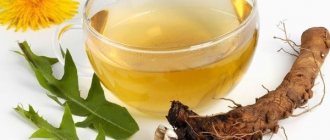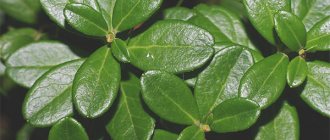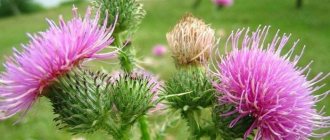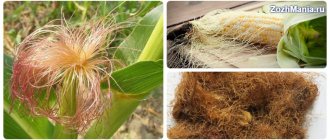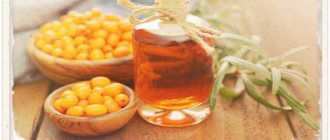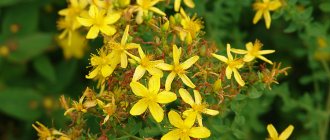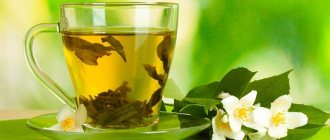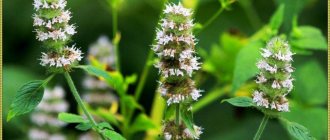Horsetail is a perennial herbaceous plant. Due to the fact that the rhizome is located at a sufficiently deep distance from the top layer of soil, horsetail is able to withstand severe, but not prolonged frosts. It is a well-known plant, has various healing properties and is actively used in both traditional and folk medicine. Our ancestors also used this plant for medicinal purposes for many ailments. Horsetail is unpretentious - it can be found in fields, on roadsides, in summer cottages, in forests and ravines.
Morphological description
Horsetail grass reaches a height of 40-50 cm, has a long creeping rhizome, on which short branches are formed in the form of tubers for vegetative propagation of the plant, accumulating nutrients.
There are 2 types of above-ground shoots:
They are unbranched, have a brown or pinkish color, and are distinguished by triangular leaf teeth of brown color. After the spores ripen, the chlorophyll-free shoots die off or become green, form lateral branches and in this form are no longer distinguishable from vegetative shoots. At the top there is a spore-bearing oval-cylindrical spikelet. |
Vegetative form The grass is green. Inside, the shoots are hollow, erect or rising above the ground, with branches and a smooth surface. |
The leaf teeth are united into whorls from 6 to 16, which grow together or remain free. The branches in whorls are simple or weakly branched, looking upward. The reduced leaves on the stem have a cylindrical shape. The spikelets are almost cylindrical in shape and 2-3 cm long.
It has no flowers and reproduces by spores.
Description of the plant
Horsetail is widespread and adapts well to most climate zones. It is also popularly known as ponytail, broom, cat's eye, mop-grass, tin-grass.
Due to its unique appearance, the plant is difficult to confuse among the many forest and meadow herbs. The ground part of young shoots resembles a Christmas tree, 40 cm in height, less often 50 cm. Stems come in two types:
- the first appear in early spring and are erect stems with spikelets with spores at the ends;
- the latter grow closer to summer and are among the medicinal herbs.
A distinctive feature of horsetail from other members of the family is the absence of toxic substances in it, so the use of the herb is absolutely safe.
Chemical composition
The unique chemical composition of horsetail (the above-ground part of the plant) determines its medicinal properties:
- carbohydrates (galactose, pectin, mannose, glucose, arabinose, xylose);
- resins;
- saponins (equisetonin, etc.);
- carotene;
- vitamin C;
- mineral salts;
- tannins;
- silicic acid salts;
- flavonoids (kaempferol-3-sophorazide, 5-glucoside-luteolin, quercetin-3-glycoside, apigenin-5-glycoside, saponaretin, dihydroquercetin and others);
- alkaloids (nicotine, trimethoxypyridine, equisetin, dimethylsulfone);
- organic acids (nicotinic, malic, quinic, aconitic, oxalic, fumaric, gluconic);
- phenolcarboxylic acids (vanillic, gallic, protocatechuic, ferulic, caffeic),
- fatty oil (contains campesterol, β-sitosterol, isofucosterol);
- bitterness.
All chemicals together determine the complex therapeutic effect.
- Thus, the herbal preparations of the plant are superior to renal preparations in terms of diuretic effect, have pronounced hemostatic and anti-inflammatory properties, improve the proliferation of connective tissue, accelerate tissue regeneration, especially during the tuberculosis process, activate the activity of the adrenal cortex, and normalize phosphorus-calcium metabolism.
- Flavonoids determine antimicrobial and anti-inflammatory effects;
- Horsetail helps remove lead from the body;
- Silicon compounds improve the course of metabolic processes and the condition of connective tissue, vascular walls and mucous membranes. Silicic acid salts play a special role in the development of bone tissue. In urine, these compounds prevent the crystallization of salts and the formation of stones.
- A strong diuretic effect makes the plant effective for weight loss, but it should be remembered that minerals are also washed out with excess liquid, so you should not abuse herbal diuretics. In addition, relying only on herbal preparations for the purpose of losing weight is not advisable.
Contraindications for using the plant in treatment
But, like any other plant, horsetail also has contraindications for use. It is not recommended in the following cases:
- If you have a history of diseases that affect the kidney tissue, for example, some types of nephritis, nephrosis;
- Possible allergic reactions of the body. Sometimes personal intolerance may occur, then it is better to stop using it;
- If there are severe lesions of the mucous membranes, including the stomach, esophagus, intestines, as well as the presence of peptic ulcer;
- With hyperfunction of the thyroid gland;
- With caution during pregnancy and breastfeeding;
- If pulmonary tuberculosis, gout or diabetes is confirmed.
In all other situations, the use of decoctions and infusions of horsetail has only a beneficial, strengthening and positive effect.
Medicinal properties
Plant preparations are characterized by a number of positive effects: antimicrobial, hemostatic, anthelmintic, diuretic, antispasmodic, astringent, expectorant, antiseptic, restorative, wound healing.
This allows horsetail to be used with health benefits for a number of diseases:
- inflammatory processes in the oral cavity: periodontal disease, gingivitis, stomatitis, tonsillitis. Horsetail is also prescribed for adenoids; it helps eliminate inflammation, swelling and restore breathing.
- fungal infections caused by Trichophyton mentagrophytes, rubrum, Aspergillus niger, Microsporum canis;
- Qatar of the upper respiratory tract, chronic bronchitis and bronchial asthma;
- IHD;
- pathologies of the musculoskeletal system: radiculitis, arthritis, arthrosis, osteochondrosis, bone fractures;
- duodenal ulcer, cholecystitis and chronic cholangiocholecystitis, pancreatitis;
- metabolic pathologies (gout, mild and moderate forms of diabetes), excess body weight;
- congestion due to insufficiency of cardiac and respiratory function, which is manifested by internal and external edema (heart failure, congenital heart defects, pleurisy with large exudate);
- urinary tract diseases: cystitis, pyelitis, urethritis, urolithiasis;
- atherosclerosis of blood vessels of the central nervous system and heart;
- hemorrhoids, nasal and uterine bleeding;
- the medicinal properties of horsetail allow it to be used for women with metrorrhagia and inflammatory processes;
- insufficient supply of minerals or impaired absorption in elderly people;
- tuberculosis of the lungs and skin (prescribed in parallel with chemotherapy treatment);
- lead poisoning, acute and chronic;
- external chronic sluggish purulent wounds, ulcers, as well as abscesses, lichen, boils, eczema, neurodermatitis, psoriasis, dermatitis;
- dandruff, seborrhea of the scalp, hyperkeratosis, baldness.
Features of the appearance of horsetail
Horsetail is one of the most common varieties. It has a number of significant differences from its counterparts:
- The branches are directed vertically upward. In other species, this part, as a rule, grows either downward or horizontally to the sides;
- The spore-bearing spikelets of horsetail do not remain at the ends of the branches (like many others), but fall off, giving way to new shoots, which are medicinal raw materials.
The plant is not at all dangerous for humans, although there are some species considered poisonous. But we are talking specifically about the medicinal properties and contraindications of horsetail , so we will not focus on other varieties of the plant.
So, let's look at the hero of our story from other points of view, including medical.
Pharmaceutical preparations with horsetail
PhytolysinPhytolysin is a combined preparation of plant origin in the form of a paste for obtaining a solution for internal use for inflammatory diseases of the urinary tract of an infectious nature and nephrourolithiasis; |
Horsetail herb (Herba equiseti)Dry plant raw materials with a wide range of applications. |
Extract liquid or dryIt has many indications and is used: to stop nosebleeds, treat diseases of the urinary system, enuresis, improve the condition of problem skin, etc. |
Contraindications:
Contraindications for horsetail are as follows:
- Nephritis and nephrosis;
- Heavy internal bleeding;
- Pregnancy (causes uterine contractions);
- Lactation;
- Children under 3 years of age;
- Individual intolerance.
You cannot take medications from this plant for more than 3 months in a row. It contains the enzyme thiaminase, which breaks down vitamin B1, so the use of horsetail preparations for more than 3 months leads to the development of a deficiency of this vitamin. The potassium content in the blood also decreases, which, coupled with a pronounced diuretic effect, leads to hypokalemia, so this indicator should be monitored during treatment. Incompatible with lithium drugs - it slows down their natural elimination from the body, which is fraught with the development of side effects. The use of this plant must be agreed with the attending physician - only this is a guarantee of safe and effective treatment.
In addition, it should be remembered that treatment with medicinal herbs requires compliance with THESE RULES:
Scientific research on horsetail
- Mentions of an amazing plant were found in the works of Avicenna and Pliny, dating back to the 1st century BC, which was positioned as a unique hemostatic agent.
- The first works of domestic scientists on the study of the composition of the plant and its properties appeared in the 40s. XX century.
- The presence of flavonoid substances and phenolcarboxylic acids in the composition was described by Czech scientists in the 1980s, who studied the composition of the plant using thin layer chromatography.
- In 2008, at the Siberian State Medical University, the antitoxic, diuretic, antiexudative and antifungal effects of the plant extract were proven both in vitro and in vivo.
- In 2019, at the Kursk Medical University, an experimental study of the diuretic activity of the plant infusion was conducted on outbred white rats, during which an increase in diuresis in the experimental group of animals was proven by 95.7%.
Internal use
From time to time, products based on horsetail can be used for preventive purposes, but there are also direct indications for their use.
Among them are:
- Damage leading to internal or external bleeding.
- Eating disorders , the main symptom of which is diarrhea.
- Skin infection with a fungal infection , the presence of a large number of pimples, acne.
- Ulcers of various types and origins.
- Cholelithiasis.
- Arthritis, osteochondrosis, arthrosis.
- Deterioration of the condition of the nail plates or hair.
- Baldness in the initial stages.
- Decreased immunity , frequent susceptibility to respiratory diseases.
- Metabolic disorder.
- Presence of worms.
- Lead poisoning.
- Phlebeurysm.
- The onset of the menstrual cycle.
At the same time, this plant also has certain contraindications; you must first make sure that they are absent:
- Pregnancy at any stage , breastfeeding, as well as the postpartum period.
- An allergic reaction to the plant or any of its components.
- Impaired kidney function , since taking a horsetail-based product increases the load on them.
- Acute cardiovascular failure.
- Inflammatory processes affecting the reproductive system.
- Bleeding after miscarriages.
- External use is contraindicated for the most complex wounds that affect large areas, as well as the presence of allergic rashes, regardless of what caused them.
Folk recipes with horsetail
Medicinal tea
- It has a low concentration of active substances and is indicated for the prevention of the above diseases or at the initial stage of pathologies. Especially recommended for older people and all people in the autumn-winter period. 2 tsp dry herbs, pour 0.2 liters of boiling water and for 30 minutes. insist, strain. Second method: the raw material in the same volume is mixed with 200 ml of cold boiled water and infused for 12 hours.
- Take the resulting volume in small sips, 3-4 times a day, for 2-3 months.
Decoction
- Place 20 grams of dry herbs in a saucepan, add 200 ml of boiling water, cover with a lid and heat in a water bath for half an hour. Cool until warm, filter, squeezing out the raw materials. The volume of the decoction is adjusted to 200 ml by diluting with warm boiled water.
- Indications: edema of renal, pulmonary and cardiac origin, including against the background of exudative pleurisy, heart failure, inflammatory diseases of the kidneys, bladder; Gastrointestinal tract disease, diarrhea, prevention of internal bleeding due to gastrointestinal ulcers, heavy painful menstruation, fungal infections (inside). Inflammatory pathologies of the mouth and throat (rinsing), wounds, bedsores, ulcers, eczema, furunculosis (washing), arthrosis and arthritis (warm compresses).
- Take 1-2 tbsp orally. or a third of a glass 2-3 times a day. 60 minutes after eating.
Infusion
- 20 grams of horsetail herb are poured into 200 ml of boiling water and evaporated under a warm towel for 1 hour, filtered.
- Indications: urolithiasis, inflammatory diseases of the liver and bladder, edema of cardiac origin, inflammatory diseases of the female genital area, atherosclerosis, hypertension, bone fractures (inside). Long-term non-healing wounds, suppuration, ulcers, bedsores, eczema, furunculosis, (washing), loose, porous and inflamed skin (wiping), gout, rheumatism, pleurisy (warm compresses), sore throat and inflammatory diseases of the throat and mouth (rinsing). Conjunctivitis (instill 1-2 drops into each conjunctival sac 3 times a day). Used for hair as a rinse after washing.
- Take 1-2 tbsp orally. l. 3-4 times a day.
Juice
- Wash the fresh herb thoroughly in cold running water, chop it and squeeze out the juice. Store in a cool place.
- Indications: edema of various origins, treatment and prevention of varicose veins, frequent and prolonged viral diseases, weakened immunity (inside). Purulent, bleeding wounds (treatment). Frequent nosebleeds (put 2-3 drops into the nose).
- Take 2 tsp. up to 3 times a day.
Extract
- Sold in pharmacies and specialty stores.
- Indications: treatment and prevention of urolithiasis, decreased elasticity of connective tissue, weak hair and nails, atherosclerosis (treatment and prevention), lead intoxication, cough and wheezing in the bronchi, tuberculosis of the skin and lungs, diabetes mellitus, weakened immunity, rheumatic pain (inside) . Sore throat and gum inflammation (rinsing). Fungal infections (external treatment).
- Take ½ teaspoon 3-4 times a day. To obtain a liquid extract from a dry briquette, pour 200 ml of water into ½ of a briquette, boil for 30 minutes and filter.
Alcohol tincture
- It is a general tonic and improves metabolism. Take 20 gr. herbs and pour 1 liter. white wine, leave for 7 days, strain.
- Take 2 tbsp. on an empty stomach, 2-3 weeks.
Ointment
- It is an antiseptic and wound-healing drug. Take 1 part of dry crushed raw materials, add 4 parts of Vaseline and mix.
- Lubricate ulcers, cracks, purulent wounds with ointment.
Baths
- 100 gr. dry herbs, pour 1 liter of boiling water, leave for 30 minutes. and added to a standard bath.
- Indications: poor circulation in the extremities, reduced metabolism, frostbite and suppuration of the skin, rheumatic diseases, joint diseases, gout. Sweaty feet and hands (local baths).
- Take a bath for 10-15 minutes, repeat after 1 day. Per course: 15-17 baths.
Use for home treatment
Traditional medicine has accumulated many recipes for using this plant to heal sick people and maintain health for the purpose of prevention. Herbalists successfully use its anti-inflammatory, diuretic and expectorant effects as an antiseptic.
Tinctures and infusions, decoctions and teas, ointments and oils are prepared from it.
How to prepare a decoction
Pusher decoctions are used as a diuretic for kidney and heart failure, diarrhea, internal ulcers, and heavy menstruation. Used to relieve inflammation of the oral cavity by rinsing, used externally to treat wounds and cuts, and compresses for arthrosis and arthritis.
The concentration of decoctions and dosage of use may vary, depending on the nature of the disease and the individual person. More concentrated decoctions are also used to treat skin diseases and wounds.
Preparation: A decoction is most often prepared from a tablespoon of dry herb poured into a glass of boiling water, which is boiled for just one minute, and then left for a few more minutes.
Take it four times a day, a tablespoon. Be sure to take breaks during the treatment process.
Infusion
Infusions are prepared in different ways: cold and hot. They are used to relieve inflammation of the bladder and liver, women's diseases, hypertension and atherosclerosis, treatment of the respiratory and digestive organs. For conjunctevitis, drop 1-2 drops into the eyes; for sore throat, rinse the throat and mouth.
Infusions and decoctions are useful for women suffering from uterine bleeding and heavy menstruation. During lactation, cracks in the nipples are treated with a light decoction.
A cold infusion is prepared from three tablespoons of raw materials, poured with two glasses of cold water and infused for 24 hours at room temperature.
This infusion is also used for taking healing baths, for the treatment of joint pain, rheumatic and chondrotic in nature, and for skin diseases. The infusion is suitable for rinsing hair, lotions and compresses.
A hot infusion is prepared from a tablespoon of raw materials poured with a glass of boiling water. This infusion requires only 30 minutes of infusion. The hot infusion is recommended for use both internally and externally, and in a decoction dosage it is used for internal diseases.
How to brew tea
Herbalists advise brewing and drinking tea to prevent diseases of the respiratory system and to treat it. Pour two teaspoons with a glass of boiling water and the tea is ready.
To improve effectiveness, complex teas are prepared by mixing horsetail with other medicinal plants.
Collection of herbs for tea . Collect herbs in equal proportions: plantain, horsetail and thyme, mallow and linden flowers, fennel seeds and elderberry fruits. And pour two teaspoons of the mixture into a glass with boiling water and let it brew for 10 minutes.
This collection supports the immune system well, relieves symptoms of influenza and ARVI. During illness, you can take up to two cups per day.
Tincture
Alcohol tinctures are prepared using vodka and wine. Equisétum arvénse is infused with wine and taken as a general tonic that normalizes blood circulation, cleanses the blood, and improves metabolism. The tincture is prescribed in the complex treatment of tumor processes of the digestive organs.
Preparation: Infuse 20 g of dry raw material per liter of white wine. Infuse for about one week, in a dark place and take two tablespoons once for 3-4 weeks.
The tincture helps well with internal bleeding, but fresh juice stops it even better.
The juice is squeezed from the juicy green leaves of the herb and taken for reduced immunity and bleeding, both internal and external. Treat purulent wounds and bleeding wounds with juice. To stop internal bleeding, take 20-50 ml of juice three times a day.
The extract is used for diseases of the urinary system, for the treatment of atherosclerosis and for the purpose of prevention, for bronchial diseases, diabetes, rheumatism (to relieve pain). Drink half a teaspoon three or four times a day.
How to prepare ointment
The ointment is often used as a wound-healing and antiseptic agent. The base of the ointment is butter or goose or pork fat, and Vaseline is also used. One part of dry herb, crushed into powder, is mixed with 4 parts of the selected base. The ointment is used for external purposes, treating purulent wounds, healing cracks and ulcers.
How to make butter
It is very easy to prepare oil at home; you just need to infuse the young branches of the plant in any unrefined vegetable oil. I want to say right away that this oil is not found on sale. It is produced for individual orders by some cosmetic companies.
How to prepare: A glass of crushed pistils or young vegetative twigs, pour a glass of oil. Olive or sunflower oil is better, given their neutral effect on the skin. Place the container in a dark place, remembering to shake the contents periodically, for two weeks. After steeping, strain and pour into a dark glass bottle.
The oil can be used externally. It relieves swelling on the face well, removes vascular mesh on the skin, treats any inflammatory processes, especially acne, and is used for enlarged pores.
Some cosmetologists claim that its effect on the skin has a lifting effect, so it will be useful for middle-aged and elderly women.
Well prevents the formation of stretch marks during pregnancy. It is necessary to lubricate the stomach in places where stretch marks are more likely to form. And the skin will remain just as soft and beautiful. But pregnant women need to consult with their doctor in order to exclude contraindications inherent in the plant.
Highly specialized fees and formulations
Collection for the treatment of tuberculous lymphadenitis
- Take 50 gr. horse tail, 30 gr. knotweed and gentian roots, mix: 2-3 tbsp. collection, pour 500 ml of water and boil over low heat for 10 minutes.
- Drink 100 gr. 4 times a day. before meals.
A remedy for the treatment of adenoids in children
- Grind fresh or dry grass, take 2 tbsp. l., pour half a glass of boiling water and wrap in a towel for 40 minutes. Strain. Fresh product is prepared every day.
- Treatment is prescribed for 3-4 weeks. Place 5 drops in each nostril 3 times a day. The procedure is well tolerated, but in order for the drops to get deep into the nose, before instillation you should rinse with any preparation based on sea water. On day 2-3, heavy discharge may appear from the nose - there is no need to stop treatment, this is a normal reaction.
Decoction for osteoporosis, arthritis, rheumatism
- 100 gr. Pour 1 liter of water over the plants and place on low heat until the volume of water is reduced by half. Strain and add 250 g to the broth. honey, place in a water bath for 30 minutes, skimming off any foam that forms.
- Take 1 tbsp. up to 5 times a day.
Decoction for gallstones
- Take 1 tbsp. pusher, 2 tbsp. knotweed and 6 tbsp. rosehip roots, stir and pour the mixture with 3 glasses of water. Cook for 15 minutes over low heat. Leave for 1 hour.
- Take half a glass 2-3 times a day. before meals, 1 month.
Medicinal collection for the treatment and prevention of diseases of bones and joints
- Take 10 grams. horsetail, linden blossom, mallow flowers, plantain, 5 g each. elder flowers, thyme, fennel fruits. The raw materials are mixed, take 2 tsp. mixture and pour 1 cup of boiling water, cover with a lid for 20 minutes, filter.
- Take 100-150 ml 3 times a day, with honey, for 2-3 months.
Remedy for acne and “unclean” skin (with eczema, psoriasis)
- Mix horsetail with linden flowers in equal proportions, take 1 tbsp. collection and pour 1 cup of boiling water, leave for 1 hour.
- Wipe problem areas of the skin with warm infusion at night. To treat the face, the infusion can be frozen and rubbed into cubes onto the skin.
Application in cosmetology
Horsetail is widely used in cosmetology. Using a decoction of this plant for hair, you can achieve an amazing effect. Many years of practice have shown that hair products containing horsetail have the most beneficial effect on the condition of the hair and scalp. Firstly, hair loss is significantly reduced and often completely stopped. Secondly, the structure of the hair changes: from dull and thin, it turns into shiny and thickened. This, of course, makes it possible to achieve the effect of thick hair desired by many representatives of the fairer sex. In addition, regularly rinsing your head with horsetail decoction will help get rid of scalp skin problems such as dandruff and fungus.
Let's look at the most popular and effective hair products based on horsetail.
Remedy 1
For 1 liter of water you will need 50 g of dried herb. Place on the fire, wait until it boils, reduce the heat to low and leave to simmer for 5–7 minutes. Remove from heat and pour the product into a thermos. Wrap in a warm thick cloth and leave for an hour. Strain. Apply the finished infusion to the hair along the entire length from roots to ends and massage into the scalp. Wrap your head in a towel and quietly go about your household chores for 30 minutes. After the specified time has passed, remove the towel. Allow hair to dry naturally. There is no need to wash off the applied decoction. To achieve a visible effect, you need to regularly use this remedy for several months, at least once a week.
Remedy 2
Against hair loss, horsetail can be used not only for external use, but also for internal use. You need to prepare a simple but very effective decoction. Just 10 g of the plant, pour 250 ml of boiling water. Leave for 15 minutes, drink on an empty stomach before your morning meal. The course lasts a month. An important condition: use must be regular, not skip a single day.
Remedy 3
Based on horsetail, you can prepare a miraculous mask at home that can activate hair growth. Its regular use allows you to quickly increase not only length, but also volume.
To prepare this remedy, you need to take 2 tablespoons of yeast and a decoction of horsetail, which you prepare in advance (2 tablespoons of the plant for 1 glass of hot water). Pour the broth over the yeast, mix well until it reaches the consistency of liquid sour cream, and leave for 15–20 minutes in a warm place. Apply the resulting mask to your hair and carefully distribute it over the entire length. Wrap your head and leave for 40–50 minutes. Wash off with shampoo. Use regularly, at least once every 10 days until the desired effect is achieved.
If you don’t have the strength or desire to prepare your own hair products using horsetail, then don’t be upset. Today in stores you can easily find hair care products that will certainly contain horsetail. The assortment is large - from shampoos and balms to ready-made professional masks.
You should definitely pamper your hair with horsetail preparations. Regardless of what product you use, ready-made store-bought or homemade, the result will pleasantly surprise you.
The perennial herb horsetail has an equally positive effect on the skin. Thanks to its antibacterial and anti-inflammatory properties, it is actively used by modern cosmetologists not only to treat acne, acne and other skin diseases, but also to increase the elasticity of facial skin, slow down the aging process and fight the first wrinkles. Cosmetic procedures and preparations using horsetail can give the skin beauty and health. The simplest, but very effective remedy for the face is, of course, ice cubes made from horsetail decoction. Cooking will not take much time. You need to pour 2 tablespoons of the dry plant with a glass of hot water. Let it brew for half an hour. Pour into ice cube trays and place in the freezer. Use once daily. It is better to do this in the evening after all cleansing manipulations with the face. Healing ice will relieve skin inflammation, increase skin elasticity and nourish it with useful chemical elements. Experts believe that in the fight for youth and beauty, horsetail in ice can seriously compete with expensive drugs and injections.
You can prepare a highly effective anti-wrinkle mask at home. You will need 5 g of horsetail extract, which can be purchased at the pharmacy, 8 g of coconut oil, approximately 15 g of dark dark chocolate. To prepare, you need to melt the chocolate and butter, add the plant extract. To stir thoroughly. It is recommended to apply the mask to well-cleaned skin along massage lines from the center of the face. Leave for half an hour. Rinse with warm water and apply nourishing cream. Repeat this procedure several times a month. The main positive effect of this mask is its ability to smooth out wrinkles and restore intercellular communication.
For skin problems, a healing horsetail mask is good. Necessary ingredients: approximately 15 ml of horsetail decoction, calendula tincture in the amount of 10–12 drops, 20 drops of peach oil, one and a half to two tablespoons of buckwheat flour. Method of preparation: mix flour with heated broth, add tincture and oil. Mix everything well. Apply the mask with massage circular movements onto a pre-steamed face. Rinse off after 10 minutes with cold water. This mask is a very effective remedy for treating acne, restoring normal skin structure and natural complexion. The recommended course is 10 procedures with an interval of several days.
Horsetail has proven itself so well in the treatment and care of facial skin that many global manufacturers of cosmetics have begun to actively use this truly miraculous plant in the production of their products. On store shelves there is a huge selection of washing gels, anti-aging and medicinal creams, lotions, which contain ordinary horsetail.
We recommend reading:
use of quinoa in cosmetology
Read
Special diseases for which horsetail is used
We next consider a plant such as horsetail. Indications for its use are the presence of certain diseases that this herb helps to cope with in the shortest possible time:
- Osteoporosis (i.e. thinning of the bones). In this case, silicon is the most useful - a special building material that is found in horsetail.
- Horsetail is widely used for skin diseases: ulcers, wounds, boils, lichen and even eczema.
- This plant can also be used for various heart ailments, such as hypertension.
- Other diseases: rheumatism, gout, sand in the bladder, atherosclerosis, etc.
Horsetail baths are the most beneficial. Children suffering from colds are often bathed in this decoction.
Medicinal properties of horsetail - use in folk medicine
- Traditional medicine advises the use of horsetail herb in the treatment of rheumatism, urolithiasis and cholelithiasis, eye diseases, gastrointestinal neoplasms, and tuberculosis.
- The hemostatic properties are perfectly used during long and heavy menstruation; when leucorrhoea develops, it is recommended to douche with horsetail infusion; adding the herb infusion to baths will also have an excellent effect against excessive sweating of the feet; you can rinse your head if you have dandruff.
- A water infusion of horsetail is used for rinsing for stomatitis and for treating purulent wounds.
- The plant is used in complex therapy of skin diseases - eczema, dermatitis, trophic ulcers, acne, psoriasis, bedsores.
Useful properties and composition of horsetail
The top of the plant looks like a green Christmas tree, which is why it is called ponytail, pusher, panicle, conifer. A representative of the plant world has a straight reddish stem and a green spikelet at the end. It is the ground part that is used by women for medicinal purposes.
Main substances in the composition:
- flavonoids;
- phenolcarboxylic acids;
- tanning components;
- equisetonin;
- silicic acid;
- bitterness;
- fixed oils;
- alkaloids;
- vitamin C;
- mineral salts.
Silicic acid destroys pathogens, improves metabolism, strengthens bones, teeth, and nail plates. Chemical compounds make connective tissue elastic and promote the biological synthesis of collagen. To cleanse the body in case of lead poisoning, doctors prescribe horsetail preparations.
Organic acids dissolve and remove stones from the kidneys and gall bladder. Antioxidants prevent the malignant process of cell transformation and improve the body's protective functions. For the cardiovascular system, the plant's beneficial substances help cleanse blood vessels of cholesterol plaques, lower blood pressure, regulate sugar levels, and improve the blood's ability to clot.
Horsetail has a diuretic effect, relieves swelling, normalizes water-salt balance, and stimulates the activity of the adrenal glands. Decoctions are used to heal wounds, pimples, lichens, cracks, ulcers, and boils. As part of complex preparations, the plant helps to cope with thrush.
Horsetail is used to treat bronchitis, pneumonia, asthma, and colds. It reduces appetite, speeds up metabolism, cleanses the body of toxins, which is why the herb is used for weight loss.
The benefits of this healing plant for the female body are expressed in the following properties:
- astringent;
- diuretic;
- hemostatic;
- blood purifying;
- tonic;
- wound healing;
- anti-inflammatory;
- bactericidal;
- antiseptic;
- anthelmintic;
- restorative;
- expectorant.
Procurement of medicinal raw materials
It is generally accepted that medicinal raw materials are those parts of horsetail grass (always dried, but in whole or crushed form) that rise above the ground. We are talking about 30-centimeter stems of a dull green hue, with a sour taste and a faint smell.
In order to prepare them yourself, while maintaining all the beneficial properties, during collection, drying and storage you must adhere to some important rules:
- Plants should be collected on acidic soils (near a forest, along a river);
- the places in which the selected herbs grow should be in the cleanest ecological zone possible, since horsetail almost instantly absorbs poisons and other harmful substances from the atmosphere;
- collection must be carried out in dry weather, in the presence of the sun not covered by clouds, after the midday heat has passed;
- The optimal time for collection is considered to be all summer months, when the grass reaches 20-30 centimeters in size;
- the plant should be cut 10 centimeters (approximately) from the earth’s surface;
- immediately before drying, the raw materials are carefully sorted to get rid of unnecessary yellow shoots;
- You can dry the harvested horsetail well naturally - for example, in the attic; to speed up the process, you can use a special dryer designed for vegetables and fruits;
- When drying naturally, it is very important to stir the raw materials frequently to avoid rotting. The first day this should be done at least 3 times. In air, the grass will dry completely in 7-10 days;
- When using a special modern dryer, plants should be processed at no more than 45°C. After 10 hours maximum and 6 hours minimum, the workpiece will be completely ready;
- Properly dried, high-quality green raw materials should have a grayish tint and a slightly noticeable acidic taste.
Important! No washing of the collected grass (absolutely) - poorly drying wet material in most cases quickly begins to rot.
In order for dry grass to be well preserved, it is placed in bags (bags) made of paper or canvas; the packages are placed in the most dark and dry place.
Horsetail extract for diseases of the musculoskeletal system
Collagen Ultra cream is used to treat various diseases of the musculoskeletal system, pathologies of joints and cartilage.
The beneficial properties of horsetail allow it to be used in the treatment of diseases of the musculoskeletal system - arthrosis, arthritis, gout, osteochondrosis and others. Horsetail in Collagen Ultra cream is used as an external remedy. Thanks to its strong anti-inflammatory effect, horsetail helps to quickly relieve swelling and swelling. You can purchase Collagen Ultra cream in pharmacies via the link: https://zapitanie.ru/gde_kupit_anfeya_i_kollagen
What does horsetail look like and where does it grow?
Horsetail is a spore-bearing herbaceous species of perennial plants, classified by scientists as belonging to the Equisetaceae family. In the spring, the characteristic black rhizome produces pale red, succulent, unbranched stems crowned with a spikelet.
In the summer, 60-centimeter, abundantly branched, ribbed green stems emerge from it, which are used directly for medical purposes. With the onset of winter, the shoots begin to gradually die and change their shades from green to pale flesh.
The leaves grow underdeveloped and are connected to each other on the stem into cylindrical tubular sheaths; sporulation occurs from April to May. The overall height of the entire plant usually ranges between 15-30 cm.
Horsetail spreads almost throughout the entire territory of the former USSR, bypassing only the southern deserts and cold spaces of the Far North.
Preparation of medicinal raw materials
Horsetail is freely sold in pharmacies at prices ranging from 30 to 60 rubles. Dried grass or filter bags with raw materials are packed in cardboard boxes.
For self-collection and preparation, follow the recommendations:
- The time for collecting plant materials that have medicinal properties is July-August.
- Cut off the barren green stems close to the ground.
- By the end of summer, horsetail already seems dried out. But this is a misleading impression. If the grass is not dried, the shoots will darken and lose their medicinal qualities. To dry, place the plant in the shade outdoors or in a well-ventilated room.
The finished medicinal raw materials are hard, empty inside, grooved branches of gray-green color. They have no smell. The taste is sour.
It is unacceptable to mix panicle with other varieties of horsetail. A few tips to help distinguish a field bush from a forest, meadow or swamp:
- Forest horsetail has thin shoots that branch in a second order.
- Meadow is characterized by downward inclined, horizontal stems.
- The branches of the marsh tree are very soft, thick and short.
- The swamp has divided cloves with white edging in the internodes.
Prepared and well-dried medicinal raw materials can be stored for up to 4 years.


